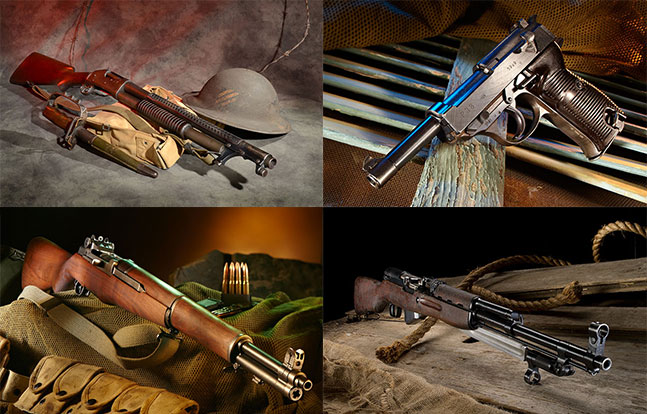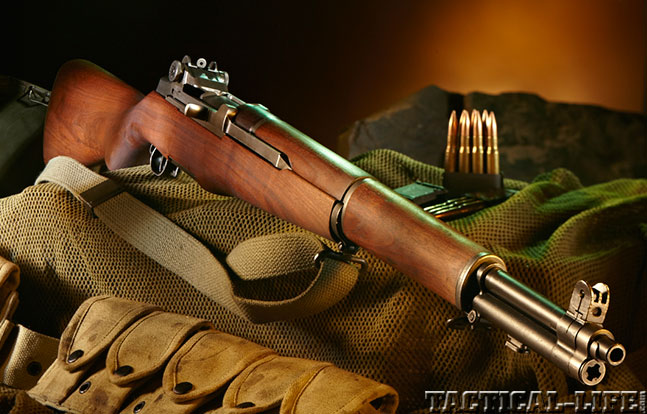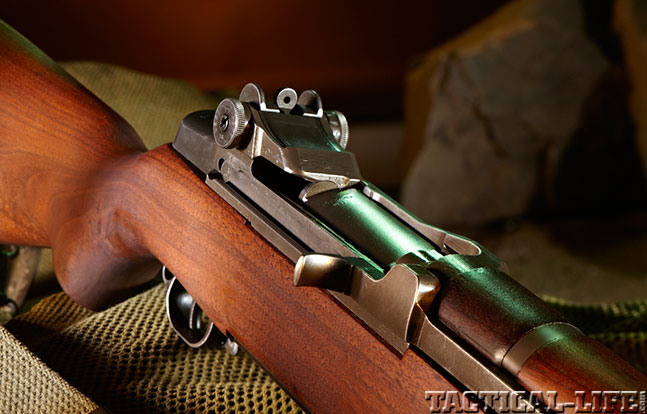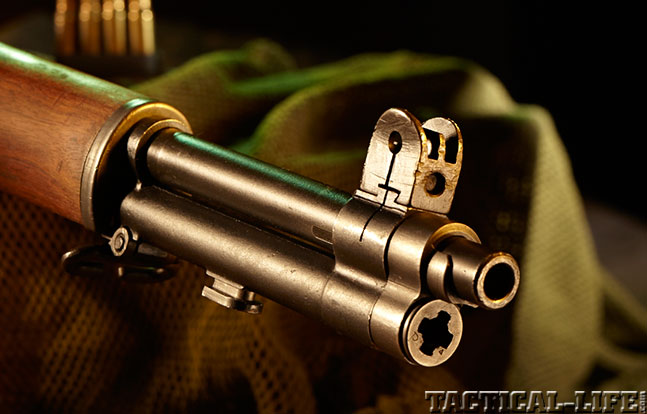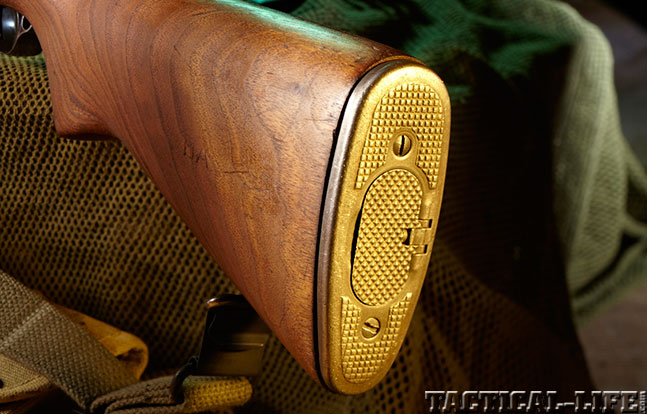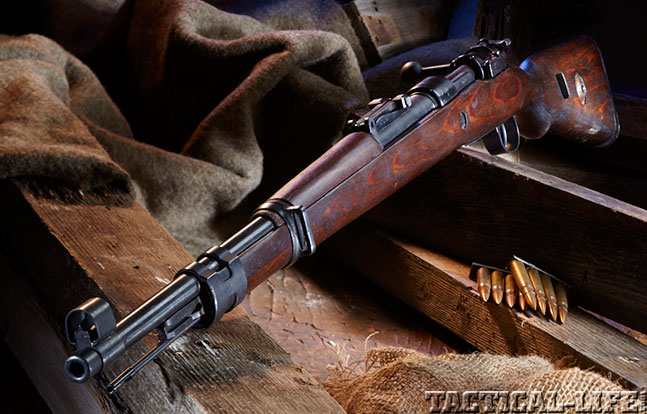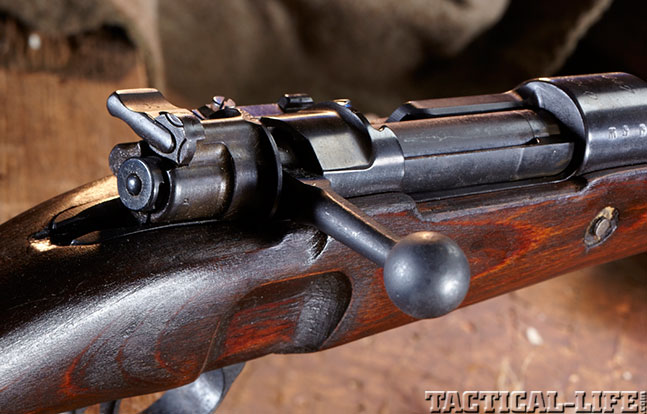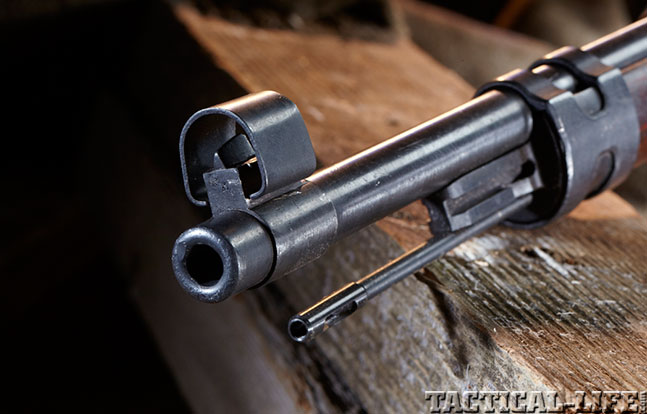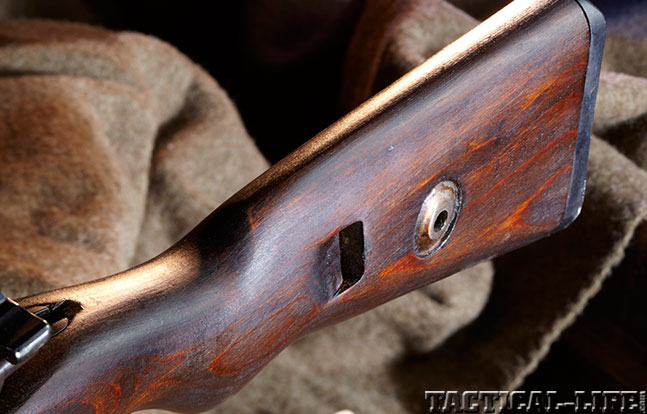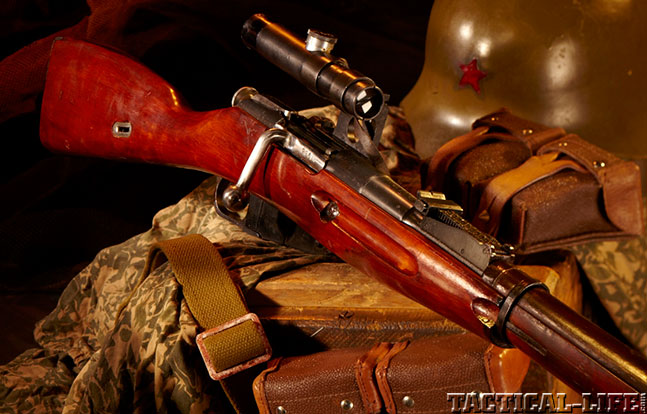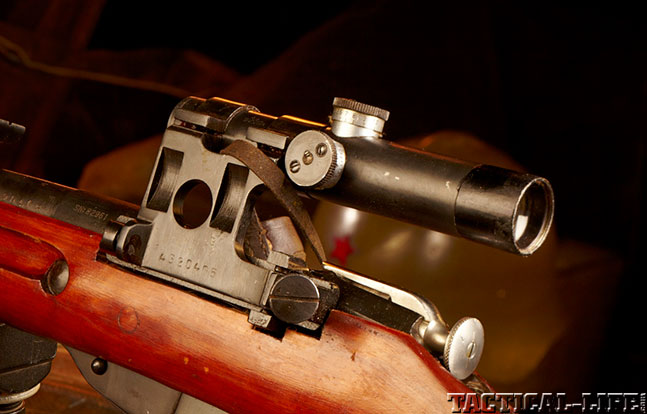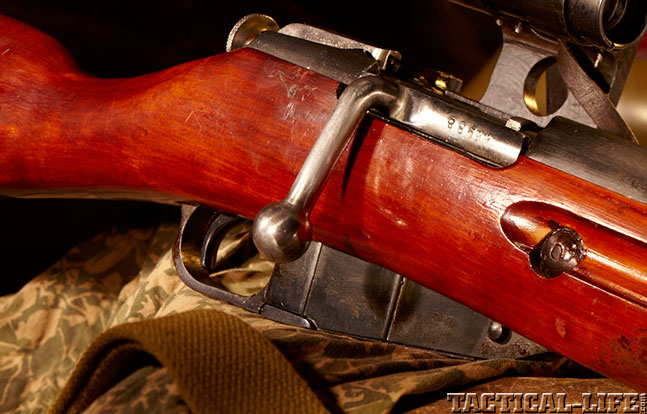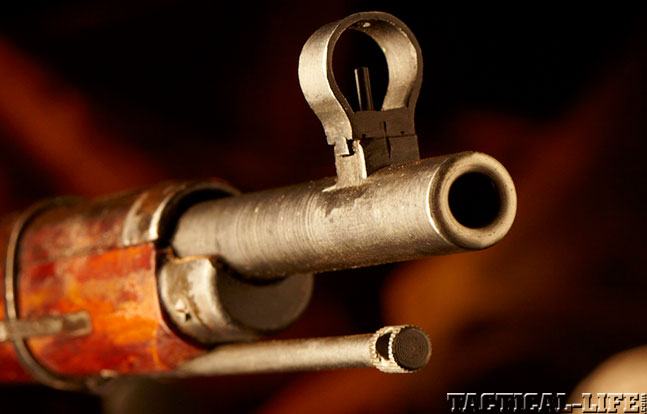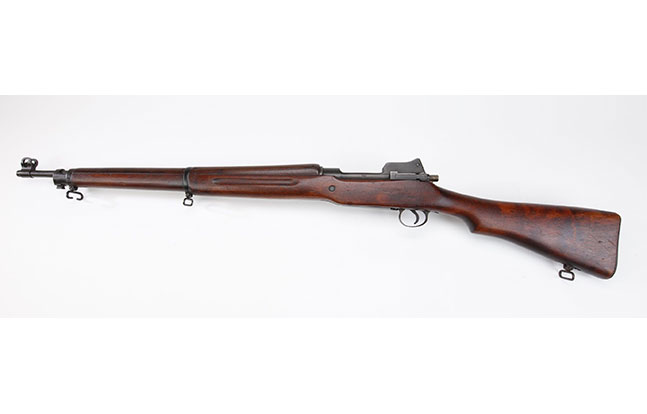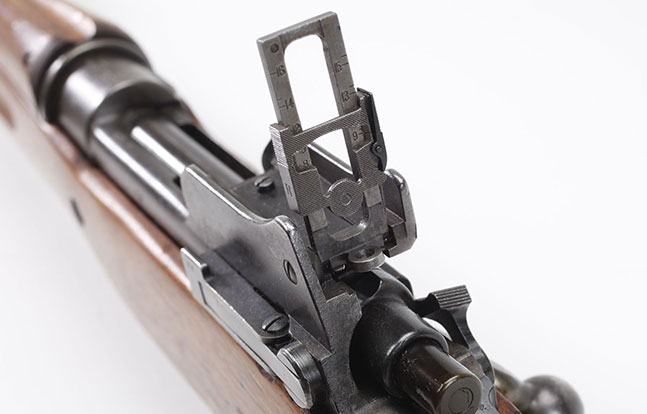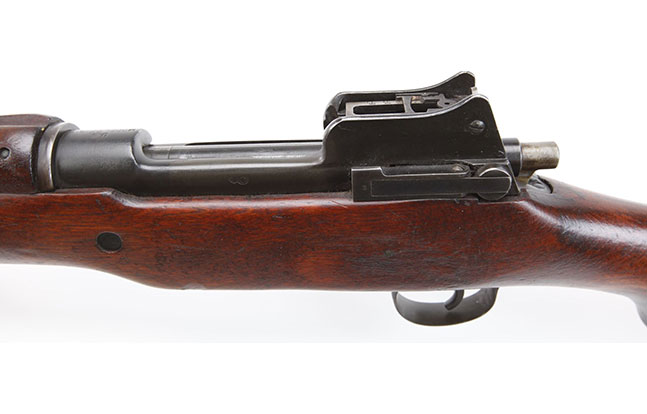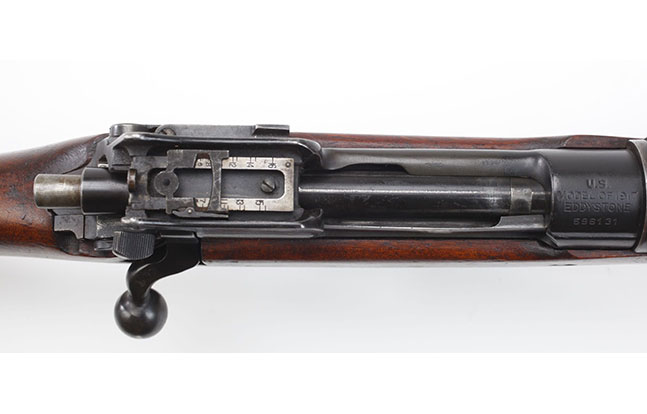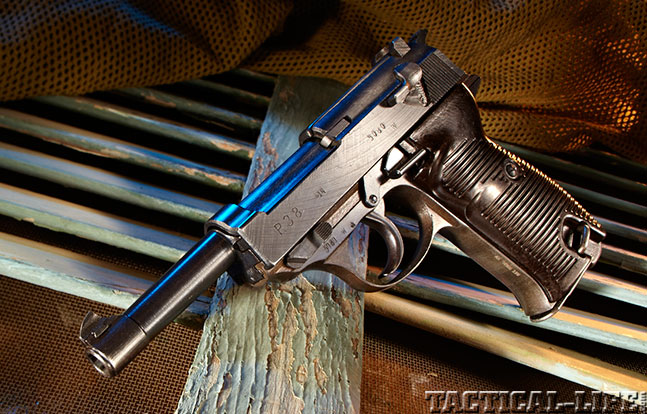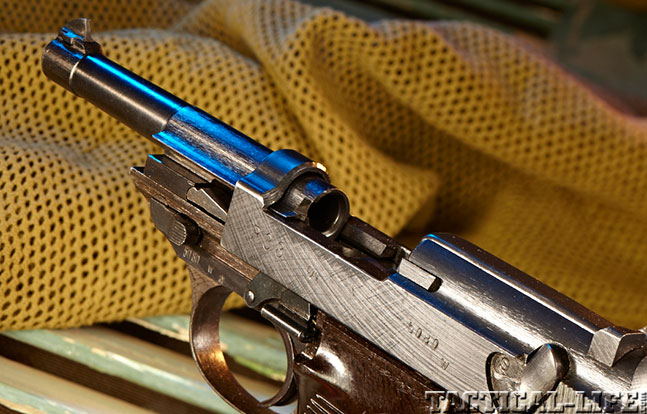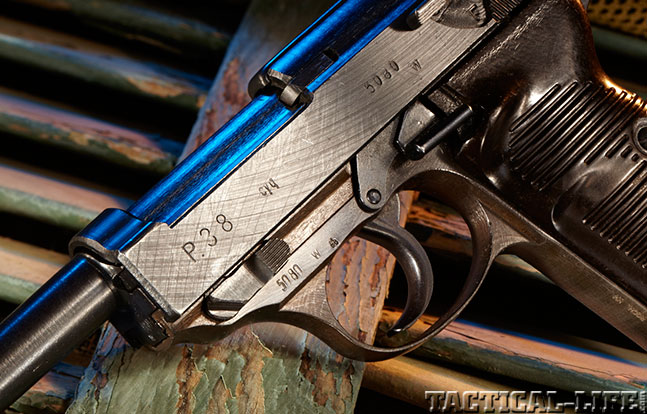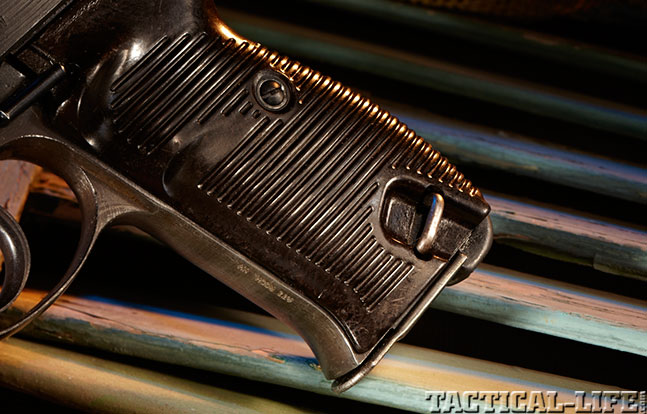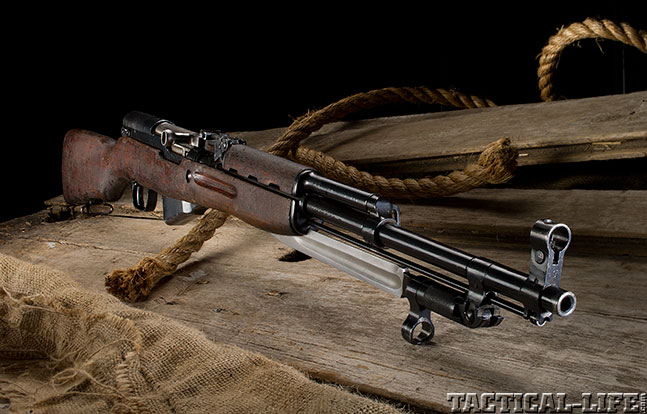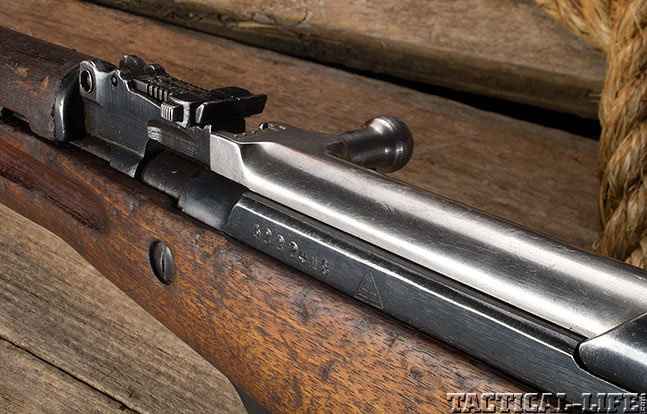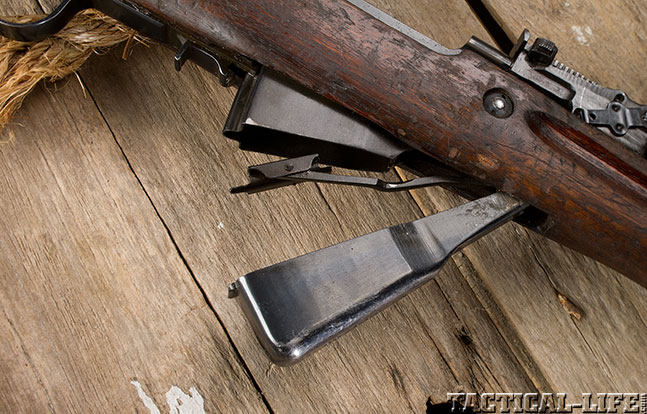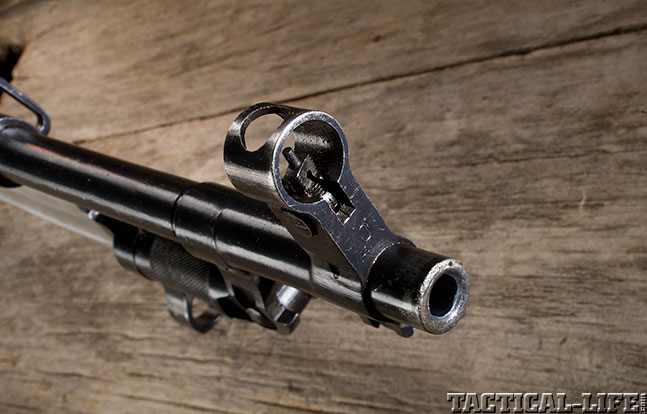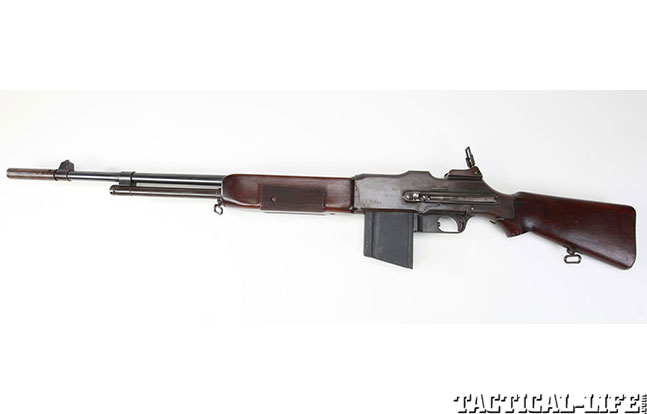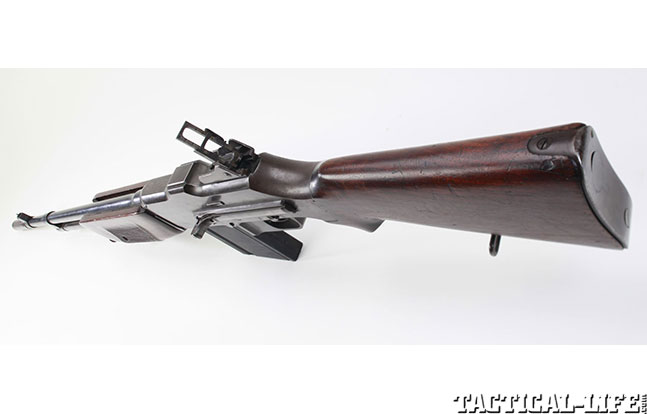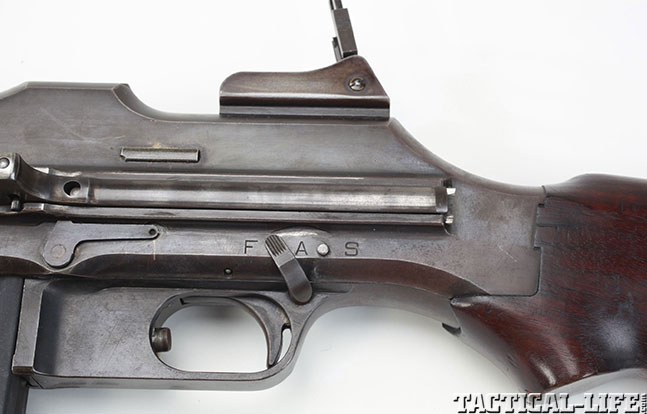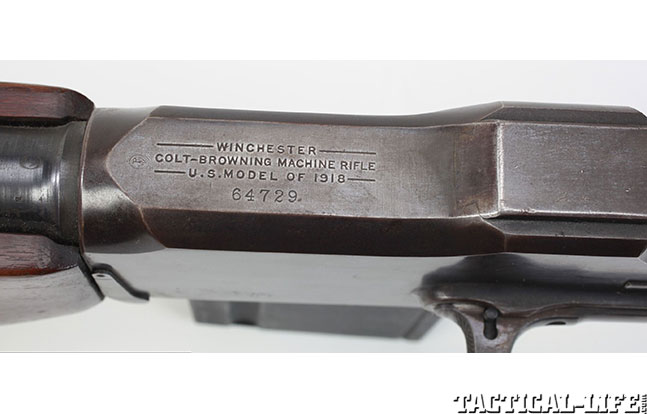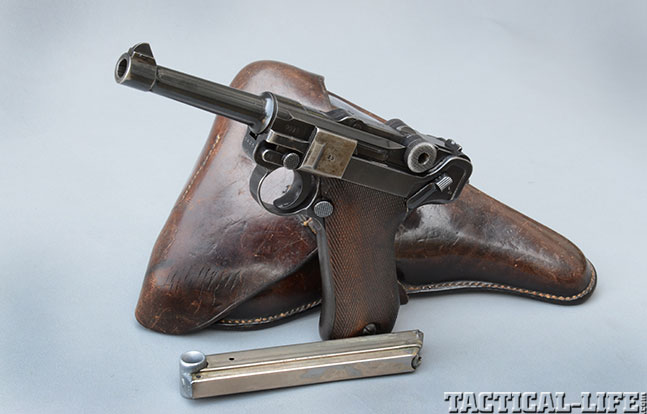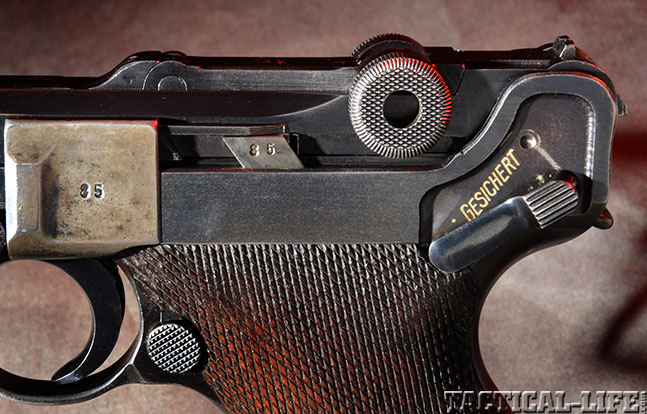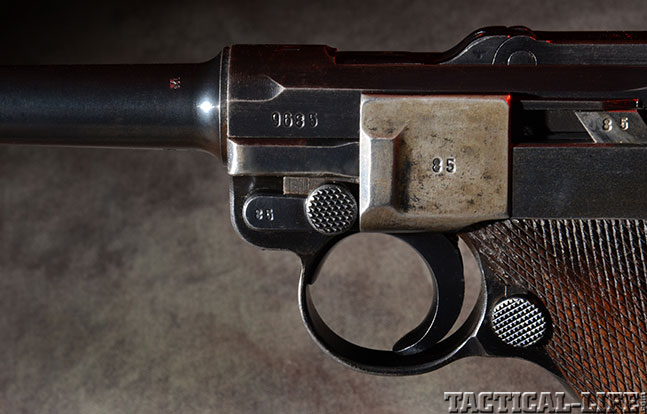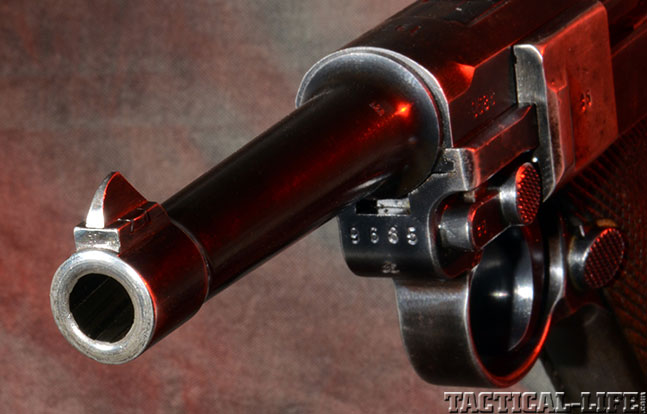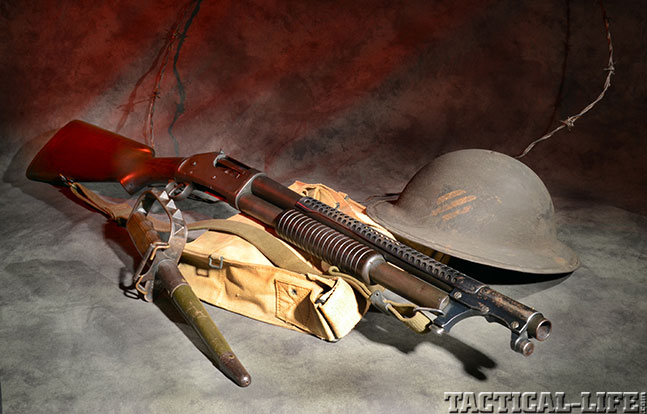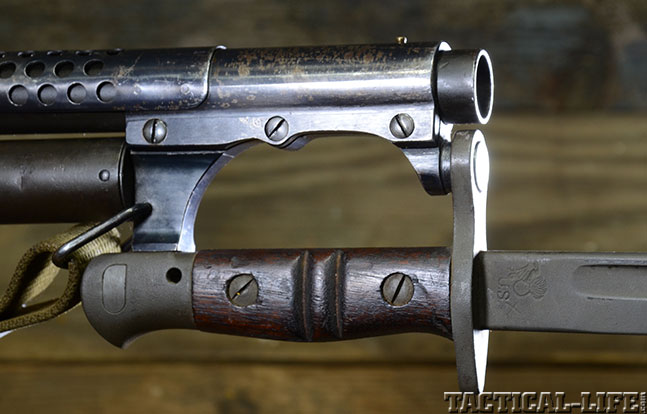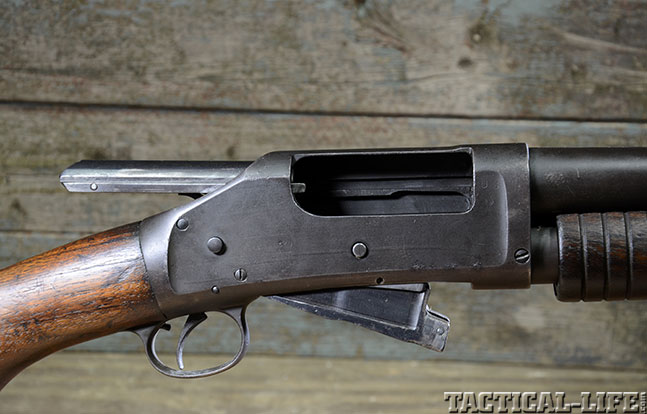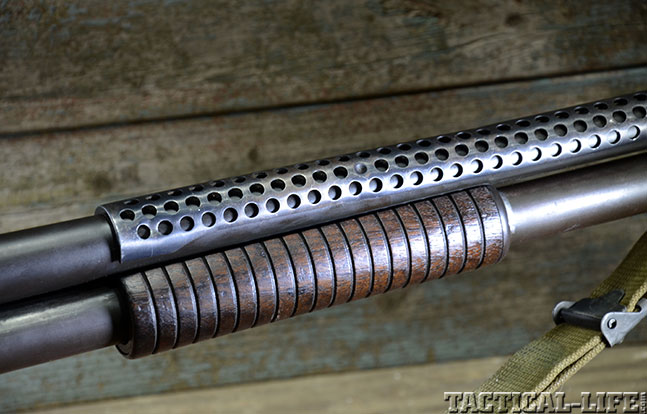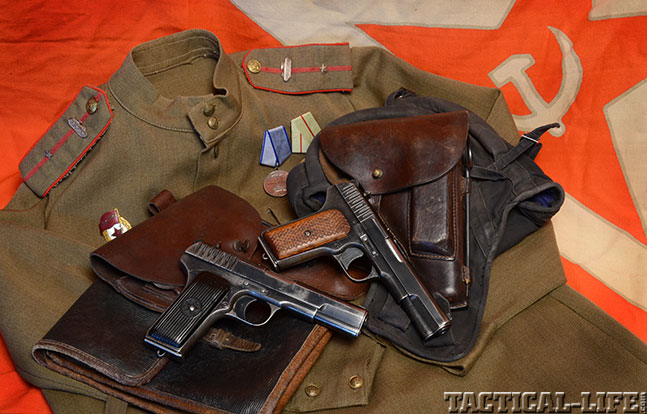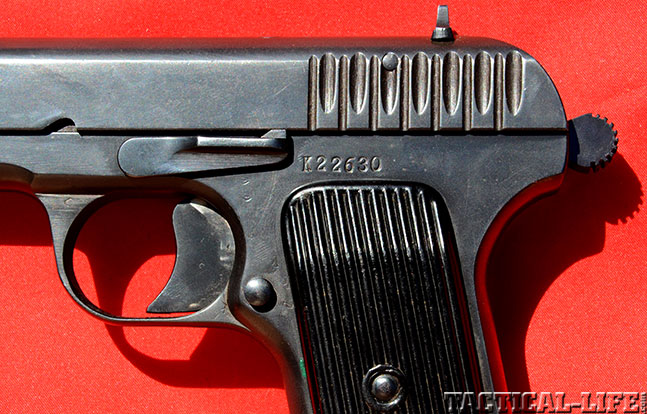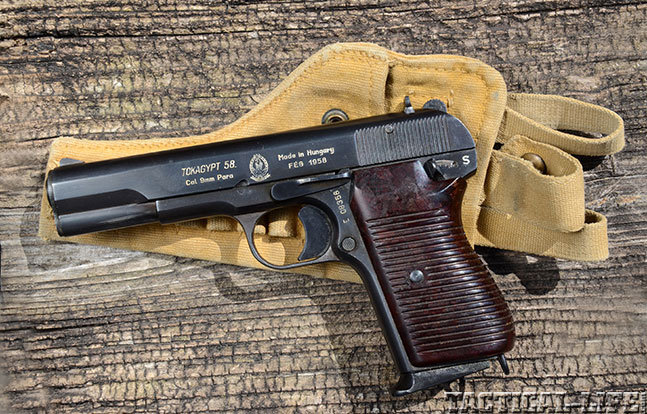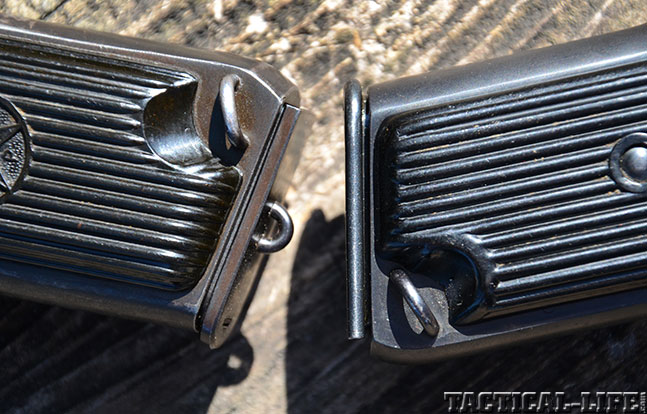While today’s newest guns with their cutting-edge designs and ultra-modern materials may be exciting and appealing to our modern tastes, there is still a great deal to be said for the walnut and steel warriors of days past as seen in MILITARY SURPLUS magazine.
- RELATED: Top 7 Collectable & Commemorative Guns
- RELATED: Top 20 Next-Gen Combat Rifles
Combining the charms of not only capable designs but also voluminous historical significance, these military surplus firearms still appeal to a broad cross section of the shooting public. Coming from all corners of the world and a dizzying array of eras, these battle-proven classics allow you the opportunity to hold history in your hands.
Read on to see examples of some of the most exciting military surplus arms out there today—from the sidearms and rifles of the everyday foot soldier to ultra-rare prototypes that helped shape the future of military small arms.
Advertisement — Continue Reading Below
AMERICA’S ORIGINAL WARFIGHTER
The internationally renowned M1 Garand—the classic .30-06 battlefield warrior!
Advertisement — Continue Reading Below
By Jorge Amselle
Sure, the AR has been the longest-serving military rifle in U.S. history, and, sure, it is extremely popular. But before you had plastic and aluminum you had 10.5 pounds of wood and steel, a semi-automatic rifle that immediately announced itself with authority when you picked it up and fired it, leaving no question of its efficacy and power.
The M1 Garand was the first semi-auto issued to American fighting men when our enemies and allies were still carrying bolt-action rifles little different from those of World War I. This revolutionary design was adopted by the U.S. military in 1936, after more than a decade of development and even then saw some key changes before ending up as the rifle carried to victory in WWII and Korea. The M1 Garand was so successful that it continued to see use in Vietnam and with reserve troops into the early 1970s, although as a frontline-service weapon it had been officially replaced in 1957. Into the 1980s, the Garand was still in use by the militaries of a dozen friendly nations, ones we equipped with the weapon, including the Greek Army.
Advertisement — Continue Reading Below
Many variants of the M1 Garand were created during and after WWII, including a never-issued tanker and paratrooper model, select-fires and ones with detachable magazines. Some were also chambered and issued in 7.62x51mm NATO, especially once the .30-06 round was phased out. The best place to get a real American M1 Garand is still through the CMP, and they have various grades available, although supplies are dwindling. Rack-grade Garands are the cheapest and have the most replacement parts and wear. The color of their metal and wood may not match, and they will have the least finish, the most throat erosion and worn barrels. They can also have foreign replacement parts, pitting of the metal and damage to the stock. The rifle pictured here is a rack-grade gun that was handpicked—the only thing I’ve done to it is lightly refinish the wood to remove some of the scratches and gouges.
Of course, you can buy a better field-grade, service-grade, correct-grade or even collector-grade rifle for a premium. Each CMP rifle is shipped with a safety manual, one eight-round clip and a chamber safety flag. Criteria for purchase are easy to meet, and CMP ships the rifle directly to your door.
Advertisement — Continue Reading Below
WEHRMACHT’S WARHORSE—THE K98 MAUSER
Born for war and refined for combat, this is the German’s 8mm military rifle perfected!
By Glenn Gilbert
Advertisement — Continue Reading Below
The last stockpiles of surplus Karabiner 98 Kurz (K98k) rifles are drying up, even as demand from collectors, hunters and shooters continues to rise. K98ks are legendary bolt-action rifles—the last in a long line of military Model 98s. They provide a rich field for collecting, a hands-on connection with history and an opportunity for enjoyable shooting. The K98k was the fruit of a tree with deep roots. And one look at the Mauser Model 98 will tell you that Peter Paul Mauser was a belt-and-suspenders man.
- RELATED: The K98k Mauser 8mm Military Rifle
Mauser’s classic bolt-action rifle is a portrait of defensive engineering at its best. He incorporated multiple redundant safety features that protect the shooter: In addition to the two fixed lugs at the front of the bolt, a third safety lug at the root of the bolt handle served as a backup. A gas escape port and a flared striker shield protected the shooter’s eyes from hot propellant gasses in the event of a case-head failure. The Model 98’s three-position mechanical safety set the standard for fail-safe design and ease of use. Another quality that defined Mausers in general, and the Model 98s in particular, was their rapid reloading. In addition to the clip slot in the rear receiver bridge, a semi-circular cutout in the right-hand receiver wall for the firer’s thumb helped ensure that the rounds were deeply and positively seated in the magazine. Also, its huge claw extractor controlled the cartridge from the moment it was presented by the follower until the spent case was kicked out by the ejector. Built for maximum durability and reliability, the Model 98 came to be appreciated by sportsmen and military shooters alike.
The K98k is a legendary bolt-action rifle with an interesting history that provides a rich field for collecting. Ten different manufacturers and countless wartime production changes helped create a wide variety of markings and unusual variants to chase down. Not to mention sniper rifles and Mauser variants the Germans produced from captured rifles and machinery like the 98/40 and G 33/40. The guns are starting to dry up, but Century Arms and a handful of other importers still have some in stock, so if you are interested in these fascinating guns, the time to buy is now. I have never regretted buying a K98k, but I have certainly regretted selling one.
Advertisement — Continue Reading Below
THE SOVIET SNIPER
The M91/30-based Mosin Nagant PU—Mother Russia’s 7.62x54R precision warrior!
By Denis Prisbrey
Advertisement — Continue Reading Below
The Mosin PU sniper rifle was built by two primary Russian arsenals, Tula and Izhevsk, and most true World War II-era PU sniper rifles were turned out from 1942 to 1944. Those from Tula were stamped CH (or CU) on their barrels along with Tula’s standard Mosin markings to designate them as specially built snipers. Izhevsk didn’t add any additional “sniper grade” markings on its PU rifles. Both companies chose the best production samples for PU builds, with better triggers and a longer bolt handle bent down to clear the scope because the Mosin’s standard short, straight bolt couldn’t be manipulated fully with glass mounted.
The 3.5x PU scope itself was developed with less tendency to fog and for more convenient mass production, and from its inception used the side mount on a base attached to the left side of the receiver. That mount allowed both good access for single-round loading through the top of the receiver and very quick use of the iron sights as backups for either rapid close-in shots or if the scope was damaged in battle. In keeping with Soviet traditions of “Fancy: Nyet; Works: Da,” the PU scopes used a combination of a relatively crude, mechanical, external elevation-adjustment method and finer internal turret adjustments for more precise final zeroing.
In use, the Mosin PU sniper rifle’s scope was extremely effective in the right hands, but quite different from what we’re used to today. The reticle’s vertical center post requires more concentration to keep the tip placed precisely on target for best accuracy through a long and heavy trigger pull than does a modern, crosshair-style mounted on a rifle with a much better trigger.
Advertisement — Continue Reading Below
For accuracy, I shot a sample 1943 Izhevsk PU from Mitchell’s Mausers with a 1944 Kazan/KOMZ optic, which matched the secondary serial stamped on the barrel shank, at 100 yards—it was an interesting experience. In a genuine PU scope, the entire reticle moves visibly inside the eyepiece as the drums are turned, and there was a notable difference in point of impact between the three loads tested. The trigger pull itself was a consistent 6 pounds, a half-pound lighter than a standard 1943 Izhevsk infantry rifle I had on hand and much smoother.
Once dialed in, the sniper rifle held a best 100-yard, three-shot group of 1.31 inches with the Hornady 174-grain Vintage Match loads, roughly comparable to military requirements. There’s some controversy over exactly what bullet weight the drums are calibrated for. If you pick up a genuine PU, you’ll need to do your own experimenting—and handloads can tighten it up considerably. A genuine Mosin PU is an important historical artifact in the world of classic military weaponry, and a study in itself.
M1917 U.S. ENFIELD
Battle-born .30-06 developed to serve with U.S doughboys in the trenches of World War I.
By Bruce N. Canfield
When the United States entered World War I, in April 1917, our armed forces were woefully unprepared for the conflict. The War Department had two options for the procurement of additional rifles. The first was to contract with domestic arms makers to manufacture the M1903 rifle. However, it was soon realized that the lag time required to acquire the necessary production tooling and train a new workforce from scratch would be too great to eliminate the looming draconian shortage of rifles. The second option would be to seek another type of rifle with which to augment the standardized M1903. The government had little choice but to pursue the second option. Fortunately, however, there was a source of available rifles.
- RELATED: Warhorse Reborn: 1917 Enfield
Three American firms had just completed manufacturing sizeable numbers of the “Pattern 1914” .303 caliber rifle under British contract. The machinery and trained workforces were still essentially intact and could go into production for the Pattern 1914 rifle for the U.S. government almost immediately. These firms were Remington, the Eddystone Rifle Plant (run by an affiliate of Remington) and Winchester.
While it was extremely fortuitous for the U.S. that these sources of rifles were available, the War Department was immediately faced with a quandary. Since it would take entirely too long for the three companies to tool up to make the M1903 rifle, the government initially considered adopting the British .303 caliber Pattern 1914 rifle. This would put the maximum number of rifles in the hands of our troops in the minimum amount of time. However, this course of action would result in logistical headaches by introducing an entirely new cartridge into American military service. Also, it was widely felt that the .303 was inferior to the U.S.’s .30 Springfield (.30-06).
Almost by default, it was decided to adopt a version of the British rifle modified for the American .30-06 round. However, it would take some time for the American arms engineers to finalize the engineering work required to change calibers, and the government was criticized by some for delaying the delivery of the sorely needed rifles. In retrospect, however, this was unquestionably the correct choice. In 1919, the Assistant Secretary of War Benedict Crowell stated, “The decision to modify the Enfield was one of the great decisions of the executive prosecution of the war—all honor to the men who made it.”
The “American Enfield” is sometimes overlooked today when considering the important U.S. military rifles of the 20th century. However, with the centennial of World War I now at hand, the historic significance of the M1917 rifle should not be forgotten. It may not have been the first choice of the U.S. military, but in the dark days of 1917 and 1918, the M1917 rifle provided valuable service to our “doughboys” at a time when they were sorely needed.
THE ELEGANT WALTHER P38
This classic military double-action pistol left its mark on WWII history!
By Glenn Gilbert
Fritz Walther, owner and lead designer for Walther firearms, created a number of semi-automatic pistols known for their elegant lines, compact size, reliable operation and revolutionary designs. In the dense woods and rugged hills of Thuringen, at the factory founded by his father, Carl Walther, Fritz created the legendary PP series of pistols. They were the first successful semi-automatics with double-action triggers. Shortly after the emergence of his .32 ACP and .380 ACP PP, the German Army advised Walther that it had begun searching for a new standard 9x19mm Luger service pistol to replace its P08 Parabellum (better known as simply “the Luger”), which had an excellent design but required substantial hand-fitting and machining.
Seeing an opportunity, Fritz Walther quickly developed a series of designs that ultimately led to the world’s first double-action, semi-automatic military sidearm (and Walther’s first pistol in 9mm Luger), the Walther P38. On first look, the P38 is a clear example of a manufacturer understanding its customer: the P38 had a simple, rugged design that could easily be mass produced. In fact, well over one million P38s were made between 1938 and 1945. It was an unqualified success, performing well and remaining in service with the German military and police—and worldwide—for over 50 years.
By any standard, the P38 is a unique piece of history. It was Walther’s first pistol in 9mm Luger and the first double-action, semi-automatic pistol adopted for military service. And while the P38 lacks the sexy allure and renown of its predecessor, the P08 Luger, it has a sinister elegance all its own. It is a proven performer, having remained in service with the German military and police for more then 50 years, and an important piece of firearms history.
CHINESE TYPE 56 7.62x39mm
Rare post-WWII SKS puts real combat history in your hands!
By Michael O. Humphries
When it comes to 20th century Soviet-era small arms, the 7.62x39mm AK-47 may be the weapon that first comes to mind. But the classic Samozaryadnyi Karabin Sistemi Simonova (known to most collectors and shooters simply as the SKS) deserves an equally respected spot of honor. While the SKS did not achieve the long-term iconic success of the AK-47, it was an extremely capable and advanced rifle for its time, serving around the world well past the point of the AK’s introduction.
- RELATED: Chinese-Type SKS Rifle 56 7.62x39mm
Developed by famed firearms engineer Sergei Gavrilovich Simonov, the SKS was the result of a new approach to not only small arms design but also cartridge configuration. Beginning in the late 1930s, the Soviets set about developing what we would now term an “intermediate cartridge,” concurrent with the efforts of the Germans who were developing their 7.92x33mm round. Upon its appearance, the new Soviet cartridge was dubbed the M43 (to indicate its year of appearance).
Eventually becoming the 7.62x39mm we know today, the M43 found its home in a self-loading carbine Simonov had developed, which featured a 10-round magazine and a folding bayonet. Produced in 1944 and sent to frontline troops for battlefield testing, the carbine proved to be a hit with the Soviet troops (no doubt due to its low recoil and semi-automatic operation).
Simonov continued refining and perfecting the design after the war’s end, recognizing that it could still serve an important role with the Red Army. The resulting weapon was the SKS. However, the SKS’ days as a frontline military rifle were numbered, as the detachable-box-magazine-fed AK-47 would soon take its place. Despite this, the SKS went on to serve with Communist and aligned forces worldwide during the Cold War and was produced outside Russia in such locations as Romania, East Germany and, as a result of early Sino-Soviet amity, even the People’s Republic of China, where it was produced as the Type 56.
RAISING THE BAR
The U.S. M1918 Browning Automatic Rifle gave our troops the edge in the trenches of World War I and beyond!
By Bruce N. Canfield
When the United States entered the First World War on April 6, 1917, it was soon painfully apparent that our armed forces were woefully unprepared regarding equipment. Other than the excellent Springfield Model 1903 rifle and Model 1911 .45 pistol, the troops of the American Expeditionary Force (AEF) had virtually no modern weapons in their arsenal. One of the most pressing needs was the acquisition of suitable automatic weapons. The Vickers water-cooled, belt-fed machine gun was procured as an interim weapon until the M1917 heavy machine gun, designed by the legendary John Moses Browning, was standardized and put into mass production.
While the heavy machine gun situation was being addressed, the War Department was also focused on the acquisition of a satisfactory light machine gun or automatic rifle in order to provide portable firepower on the squad level. On May 1, 1917, a War Department board was convened to study the problem and recommend suitable alternatives. Proposals were solicited from a number of firearm companies and gun designers. One of the designs submitted was an automatic rifle conceived by John M. Browning. Mr. Browning had previously entered into a working agreement with Colt, and the company purchased the patent rights to the weapon. After preliminary testing, the Browning Automatic Rifle, henceforth generally referred to as simply the “BAR,” was the overwhelming selection of the board. It was officially adopted as the “Rifle, Caliber .30, Automatic, Browning, M1918.”
The Model 1918 Browning Automatic Rifle was the first variant of what was to become one of the most venerable U.S. military weapons of any era. The later variants served our armed forces well in World War II, Korea and Vietnam. John Moses Browning invented many successful firearms during his remarkable career, but the Model 1918 BAR is unquestionably one of his great achievements.
PISTOLE PARABELLUM—THE P08 LUGER
Iconic autopistol that combines elegant design with battle-born capability!
By Leroy Thompson
The adoption of the Luger by the German Army—as the P08, or Pistole Parabellum 1908—played a major part in establishing the automatic pistol for military use. The German Army was so well regarded that its decision to adopt an autoloader influenced numerous other countries to do the same. Actually, the Swiss preceded the Germans, having adopted the Luger in 1900 in 7.65x21mm Parabellum (.30 Luger), but it was the German adoption that gave the Luger and autoloading pistols real credibility.
The Luger uses an operating system based on a toggle lock. As a round is fired, recoil causes the barrel and toggle-lock system to move to the rear. After moving about 0.5 inches, the toggle strikes a cam in the frame, causing the toggle and breech assembly to unlock. The barrel stops its rearward motion when it strikes the frame, but the “knee joint” hinges as the toggle assembly continues to move, extracting the empty cartridge case and ejecting it. When the toggle joint has completely bent, it travels forward under spring tension, stripping a new round from the magazine, chambering it and locking the action. It should be apparent why cartridges of powerful enough to fully operate the toggle action and fully lubricate the toggle are important for the gun’s reliability.
Ergonomics of the P08 are fairly good, given its design is over a century old. The grip, which allows natural pointing, has already been mentioned. The magazine-release button is located on the frame above the grip, in the manner used by most contemporary autos. The safety lever is fairly large and located at the rear of the frame. Unlike most modern autoloaders, pushing the safety lever upward puts it on fire, downwards on safe. When the pistol is on safe, the word “gesichert” (German for “safe”) shows. Also, a steel tab is raised to cover the striker when the safety is on. When on safe, the toggle cannot be operated. It is necessary to break the shooting grip to operate the safety lever.
Few pistols have the history of the P08 Luger. Those of us who grew up watching Combat! on TV or listening to relatives who served in WWII have images of the Luger ingrained in our minds since childhood. Anyone who has an interest in the mechanics of automatic pistols will find the Luger a fascinating study as well. Would I choose a Luger as my combat pistol today? Probably not. But if I had a chance to buy a nice collectible Luger at a good price, I absolutely would. Presently, I have an urge to get a nice WWI Luger to go with my WWII.
M97 TRENCH GUN
Winchester’s 12 gauge close-quarters scattergun that served in WWI and beyond!
By Leroy Thompson
I still remember when I bought my first Model 97 Trench Gun. I had wanted one since I first saw photos of U.S. Doughboys and Marines with the Trench Gun and read about it. The day I went to buy a much-used sample, I didn’t think of it as a collectible; I wanted to handle and shoot the weapon. Since then I’ve owned three other Trench Guns, and my current one, the World War I example, is featured in this article.
- RELATED: M97 Trench Gun
For most shooters and those with an interest in World War I, the Model 97 Trench Gun is the iconic U.S. military fighting shotgun. However, it was the Model 97 Riot Gun that first proved its effectiveness in close-quarters combat during the Philippine Insurrection. The anemic Army Colt .38 didn’t stop fanatic Moro Juramentados, and even the Krag rifle didn’t always stop them. But the Riot Gun loaded with buckshot generally did.
While serving in the Philippines, Captain John Pershing had a chance to see the effectiveness of the Model 97 firsthand. And later, as a brigadier general, he would serve as the governor of Moro Province. When Pershing led the U.S. Punitive Expedition into Mexico, he had some of his troops equipped with Model 97 Riot Guns—that included some cavalrymen who found the firearm very effective. This operation against Mexico later influenced the films The Wild Bunch and The Professionals, which portrayed these Riot Guns.
Throughout at least four wars, the Model 97 Trench Gun proved a formidable close-combat weapon. Its fearsome appearance, especially with a bayonet mounted, made it even more intimidating than the typical combat shotgun. That same martial look also has made it one of the most sought after U.S. military collectibles. The Germans, Japanese, Communist Chinese and Viet Cong may have dreaded and loathed the Model 97, but it was welcome in the hands of countless U.S. troops and has now found a home with many U.S. collectors.
RUSSIA’S 7.62mm TOKAREV
The TT33 autoloader is one of the most rugged military autopistols of all time!
By Leroy Thompson
As is the AK-47 and its descendants, the Tokarev TT33 pistol is an excellent example of Soviet arms design, which emphasizes ease of production, simplicity of operation and durability. Prior to the adoption of the Tokarev, the primary Soviet-produced handgun was the Nagant M1895 revolver.
Admittedly, the M1895 is memorable for the fact that, unlike numerous revolvers used in books and films, it can be suppressed—it has a cylinder that moves forward to seal against the forcing cone. But compared to the autoloading pistols used by other countries after World War I, the M1895 was fairly primitive. After the Russian Revolution, the Mauser M1896, especially the “Bolo” model named for its usage by the Bolsheviks, was widely employed.
By the later 1920s, however, the Revolutionary Military Council was ready for a more modern autoloading pistol. A design by Fedor Tokarev was deemed worthy of production as a result of testing during late 1930. The Tokarev design owed a lot to the Colt-Browning locked-breech system—it kept the swinging link of the Colt 1911. The Tokarev also incorporated three other features that were deemed desirable by the Revolutionary Military Council. Two features simplified production: the elimination of feed lips from the magazine, as they were machined into the pistol’s frame, and the elimination of a safety. The third feature eased maintenance: a hammer/lockwork assembly was installed, which could be easily removed as a unit. This feature would later be included on the French M1935 and is still used on the SIG P210.
The Soviets liked the 7.63x25mm Mauser cartridge for its penetration and range. As a result, the Tokarev was designed to take a cartridge based on the Mauser round: the 7.62x25mm Tokarev round. In addition to Tokarev pistols, this round would also be used in the PPSh41 and PPS43 submachine guns.
If you do decide to collect Tokarevs, do your best to find original ones without added safeties that have matching numbers, a spare magazine and a holster. Prices on nice Tokarevs have doubled over the last few years—originals will likely continue to grow in value. But if you just want a Tokarev for shooting cheap 7.62x25mm corrosive surplus ammunition, then the added safety isn’t an issue and will make your pistol safer to shoot.
